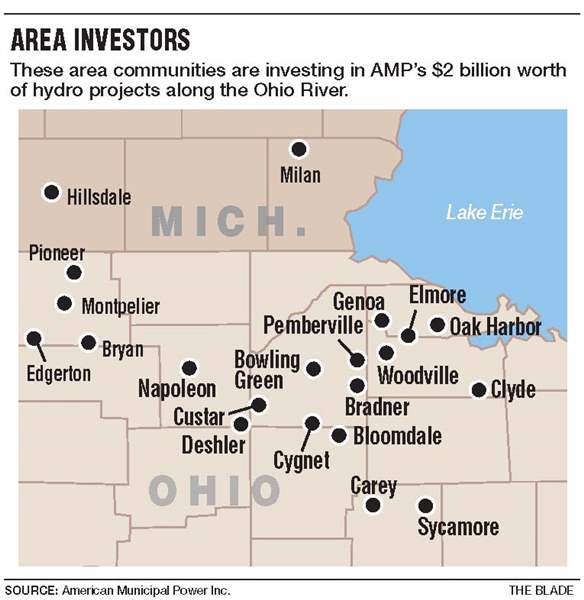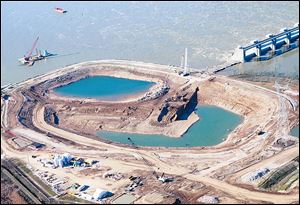
A municipal power co-op tied to area towns tackles a $2B hydroelectric project
3/7/2010

A $416 million facelift on the Cannelton Locks and Dam began in May. When the project is finished in 2013, the hydroelectric facility there is expected to generate 84 megawatts of power.
Three months after halting construction of a mammoth $3.3 billion coal-fired power plant it had proposed for southern Ohio's Meigs County, American Municipal Power Inc. is following through with a $2 billion investment in five hydroelectric projects at existing dams along the Ohio River.
Seventy-nine of AMP's 126 member communities have committed themselves financially.
Nearly a third of those investors are small and mid-sized communities in northwest Ohio and southeast Michigan, including Bowling Green, Napoleon, Bryan, Clyde, Deshler, Edgerton, Elmore, Genoa, Montpelier, Oak Harbor, Pemberville, Pioneer, Sycamore, Woodville, and Hillsdale. They're each hoping to stabilize their budgets with a clean, renewable form of energy that offers competitive prices and predictable costs. The amount of electricity that AMP provides each community depends on their respective levels of investment.
“We're doing the hydros because we feel it's the right thing to do. We feel it's going to be the least impact on our people,” said Napoleon City Manager Jon Bisher, who also chairs AMP's board of directors.

The existing dams and locks are operated by the U.S. Army Corps of Engineers. Years of water-flow data have been collected by that government agency to assist in planning for what is known as “run-of-the-river” hydroelectric projects. Those are ones that have less impact on the environment because there is minimal disturbance of river currents, Mr. Bisher said.
“Right now, we really believe this run-of-the-river hydro [technology], for this part of the country, is the best form of alternative energy,” he said.
The hydro projects span the length of the river, from the Illinois-Kentucky border to the Ohio-West Virginia border. They range from $276 million to $416 million. Each is to create 200 to 400 temporary construction jobs, up to a dozen permanent jobs, and 44 to 111 megawatts of electricity.
Together, they will add more than 350 megawatts to AMP's portfolio. Every megawatt a utility produces is roughly enough power for 1,000 homes, though the ratio is not as good when demand for electricity peaks during the summer.
The breakdown goes like this:

• Cannelton Locks and Dam began a $416 million facelift on the Kentucky side of the river in May. Once finished in the fall of 2013, that hydroelectric facility is to employ 9 to 12 people and generate 84 megawatts of power.
• Smithland Locks and Dam started having $432 million of work done on the Kentucky side of the river Feb. 16, with the execution of a contract with C.J. Mahan Construction Co. of Grove City, Ohio. Scheduled to be completed in the spring of 2014, that hydroelectric facility is to employ seven to nine people, and generate 76 megawatts of power.
• Willow Island Locks and Dam is slated to have $276 million of work begin soon on the West Virginia side of the river. Seven to nine permanent jobs are to be created, and the facility is to generate 44 megawatts of power.
• Capt. Anthony Meldahl Locks and Dam is to undergo $473 million of improvements on the Kentucky side of the river, a project being done in cooperation with the facility's license holder, the city of Hamilton, Ohio. Work has not commenced, but the project is expected to be done in early 2014. It is to employ seven to nine people and generate 111 megawatts of power.
• Robert C. Byrd Locks and Dam, near Gallipolis, Ohio, is slated for $300 million of work. The side of the river where the construction will be done has not been determined nor has the number of people to be employed once it's operating. The utility expects it to produce 48 megawatts of power.
Environmental issues
AMP has past experience with hydro power; it has operated its Belleville Hydroelectric Plant on the Ohio River since April, 1999. That plant provides power to 42 cities and towns.
The utility has found that project to be both reliable from a technology standpoint and predictable in terms of costs, Mr. Bisher said.
Founded in 1971 to negotiate electric rates for its member communities, AMP — formerly known as AMP-Ohio — is a nonprofit, Columbus-based wholesale power supplier. The company has shortened its name to reflect its broadening membership base. AMP now represents and supplies power to 126 cities, towns, and villages in Ohio, Michigan, Pennsylvania, Virginia, and West Virginia.
The timing of AMP's five latest hydroelectric projects could help the company mend fences with environmental groups, which generally see hydro as less harmful to the environment than coal.
“We are pleased that AMP is back in the ‘mainstream' again, doing what they do best — being a leader in cleaner energy,” said Trent Dougherty, director of legal affairs for the Ohio Environmental Council, a consortium of environmental groups across the state. “While hydro-power is not environmentally benign, AMP's project is a lower-impact hydro project that will help Ohio loosen the shackles of dirty coal power,” Mr. Dougherty said.
Spokesmen for two other environmental groups — the Natural Resources Defense Council and Ohio Citizen Action — declined comment on the hydro projects. Both groups opposed the coal-fired power plant.
Hydro's biggest drawback usually is its impact on fisheries.
AMP is working with state and federal officials to co-exist with native fish and mussel populations. It will incorporate a number of design features, including slow-moving turbines, to make the projects viable.
“Trust me,” said Marc Gerken, AMP president and chief executive officer. “It's fun running a hydro plant compared to a coal plant.”
Coal plant project
Mr. Bisher said he was disappointed by the backlash AMP received over the Meigs County project. He said some environmentalists who once viewed AMP as an ally for helping to bring wind power to Ohio never accepted AMP's plans to mitigate the proposed coal-fired power plant's impact with state-of-the-art pollution controls.
To environmentalists, the Meigs County project was just another dirty coal plant in the making, Mr. Bisher said.
Through their campaigns, activists enlisted people to flood mailboxes. Mr. Bisher said he received what seemed like 100 letters a day from opponents.
“I will tell you my life has gotten considerably easier from an environmentalist point of view,” he said. “You certainly don't get those letters when you're doing a run-of-the-river hydro project.”
AMP maintains its decision to pull away from the Meigs County project was in response to changing market conditions and increased labor costs — not pressure from environmentalists. “It was totally a numbers thing,” Mr. Gerken said.
The proposed coal-fired power plant was to generate 1,000 megawatts of electricity. That's more than FirstEnergy Corp.'s Davis-Besse nuclear plant in Ottawa County produces and is nearly five times the output of AMP's existing hydroelectic plant along the Ohio River.
AMP was in the early stages of building the Meigs County project but cited a 37 percent increase — or about $800 million more — between its contractor's May and November estimates.
When plans for the coal-fired power plant were announced in October, 2005, the cost was pegged at $1.2 billion. AMP pulled the plug in November following the latest of several price increases, figuring it was better off cutting its losses and terminating contracts.
Though it had planned to use a patented process that claimed to be among the most effective at removing carbon dioxide and other greenhouse gases, AMP also came to grips with the likelihood that restrictive cap-and-trade legislation could soon pass in the U.S. Senate. A bill passed in the U.S. House last year.
“If you look at where we're headed with greenhouse gas legislation — and it's coming sooner than later — we need to manage our carbon footprint,” Mr. Gerken said.
“I think we all recognize the need to be a little more carbon free,” he added. “Right now, we have no blueprint. That's why a lot of industry is leaving this country. They're not going to wait to see what the regulations are.”
Diversification
AMP has diversified with wind power, as well as hydro.
It owns the four wind turbines southwest of Bowling Green, providing electricity from them to that city and others that are part of a cooperative agreement.
AMP has proposed erecting another six wind turbines in Wood County.
But wind turbines operate at only 23 percent to 30 percent efficiency, Mr. Gerken said.
The utility is exploring an investment in solar but figures its efficiency is less, he said.
“These hydros will get you to 60 to 65 percent [efficiency],” Mr. Gerken said.
The coal-fired power plant was to generate 1,600 temporary construction jobs and 165 full-time operators.
One of the world's largest contractors, Bechtel Power Corp. of San Francisco, oversaw construction.
AMP received $30 million in federal stimulus dollars for the project.
The Andersons of Maumee had a contract to crystallize the coal-fired power plant's waste by-product, ammonia sulfate, into a fertilizer.
AMP is now looking for ways to scale down the shuttered Meigs County project and covert it to a natural gas combined cycle facility.
The utility is examining how biomass or another form of advanced energy technology could become the site's fuel source, Kent Carson, a senior AMP spokesman, has said.
Contact Tom Henry at:thenry@theblade.comor 419-724-6079.